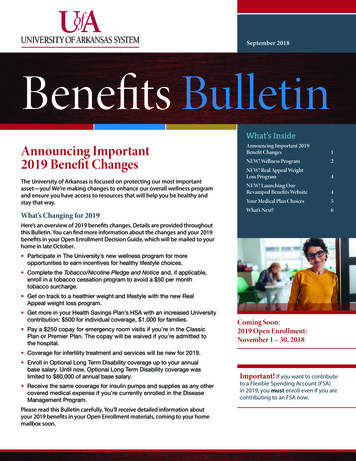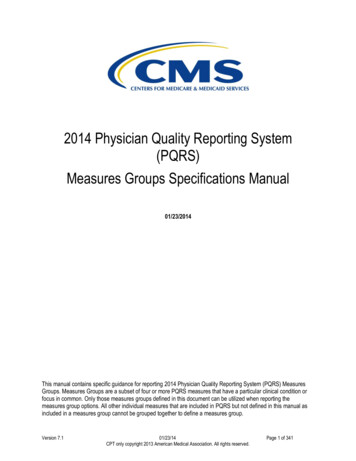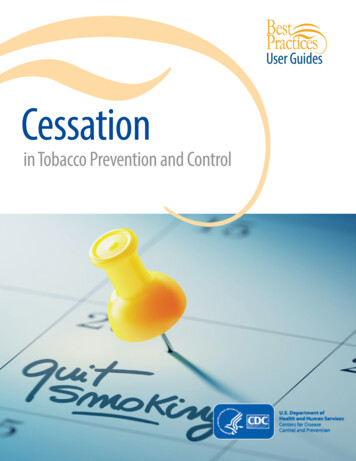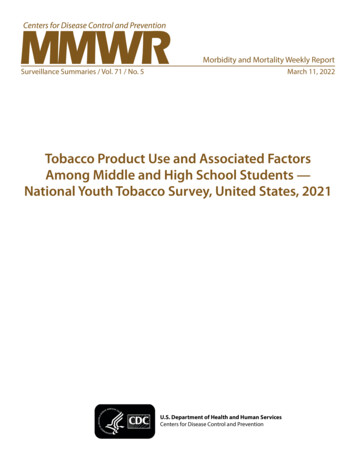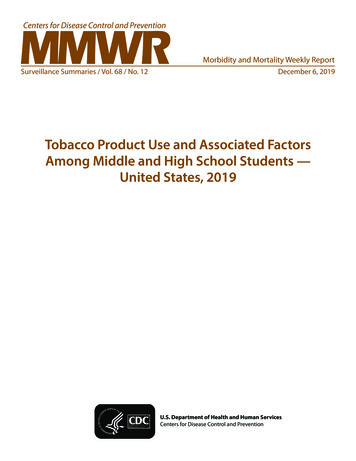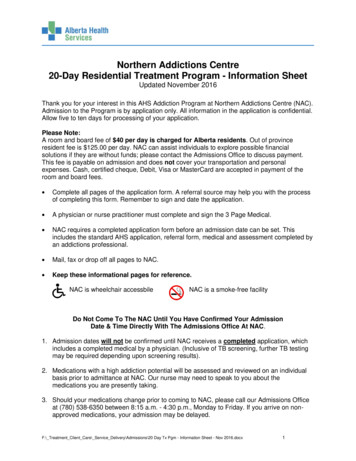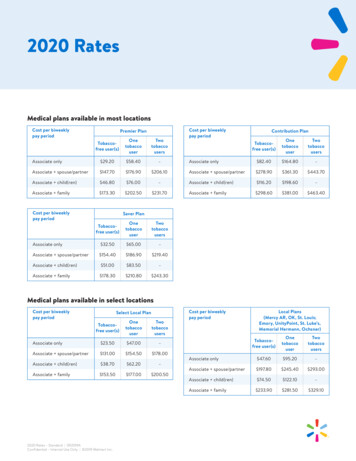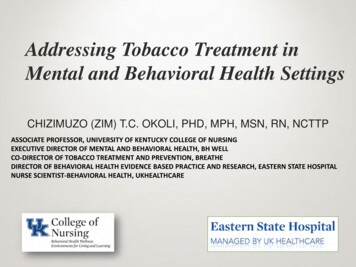
Transcription
DEVELOPING TOBACCOTREATMENT PLANSWWW.TOBACCORECOVERYY.ORG
Nelson A. Rockefeller College of Public Affairs and PolicyJeff rey Straussman, Ph.D.DeanProfessional Development ProgramEugene J. MonacoPublic Service Professor and Executive DirectorDiane TesinyDirectorTobacco Interventions Project TeamWilliam J. Panepinto, Senior Education SpecialistLisa M. Howard, Senior Education SpecialistEdward J. Perka, Jr., Manager, Principal Education SpecialistPeter J. Pociluyko, Senior Education SpecialistPeggy Dayer, Administrative Assistant IIDecember 2009The Tobacco Interventions Project was funded under a contract with theNew York State Department of Health, Division of Chronic DiseasePrevention and Adult Health, Tobacco Control Program. All materialsappearing in this tool kit, except those taken directly from copyrightedsources are in the public domain and may be reproduced or copied withoutpermission from the Professional Development Program.A citation of the source would be appreciated.Recommended citation: Professional Development Program,Rockefeller College, University at Albany, State University of New York.Developing Tobacco Treatment Plans, 2009.2
INTRODUCTIONSuccessfully integrating tobacco use interventions into treatment plans requires knowledgeof the biopsychosocial nature of tobacco dependence, the ability to perform an accuratecomprehensive assessment, and the availability of effective treatment interventions (IntegratedProgram of Therapies and Activities, or IPTA).Diagnoses for substance use disorders need to be made based upon DSM-IV-TR criteria andtreatment interventions should then be matched to the stage of change for each patient.The components of a comprehensive treatment plan, i.e., problem statements, goal statements,objectives, and interventions, will often be consistent across many agencies and modalities.The degree of integration of tobacco treatment interventions will likely vary among treatmentprograms.TREATMENT PLAN BASICS The treatment plan should be individualized and patient-driven, and should not be a“one size-fits all” or primarily “program-driven.” The treatment plan should be considered a “living document.” It needs to be revised asthe patient progresses through treatment, the patient moves to a new modality of care,or as the patient’s needs change. Treatment plans should be developed collaboratively with the patient, and shouldreflect what that patient is willing to do; it is not something that is simply imposestasks on the patient.TREATMENT PLAN DEVELOPMENT PROCESSProblem Statements(identified from the comprehensive assessment)Goal Statements(broad outcomes, which can be created by reframing the problem statements into a goal)Objectives(what specific and measurable actions or steps the patient will take to reach each goal)IPTA(what the clinician/agency will do to help the patient complete his/her objectives andachieve the goals)Professional Development Program, Rockefeller College, University at AlbanyFunded by the New York State Department of Health, NY Tobacco Control Program3
ABOUT THE CASE STUDIES AND SAMPLE TREATMENT PLANSThis document presents five case studies with patients in treatment at five different levels ofcare, followed by sample tobacco treatment plan that only addresses tobacco-related problems.(Real-world treatment plans address all issues identified in patient assessments.) Mary Ann is referred to a Medication Assisted Treatment (methadone) clinic Alvin presents for treatment at an inpatient rehabilitation facility Jorge is a patient at a detoxification unit Barbara is being admitted to a therapeutic community Bill is a new patient at an outpatient clinic4
CASE STUDY NUMBER 1: MARYANNMEDICATION ASSISTED TREATMENT5
CASE STUDY 1: MARYANNMEDICATION ASSISTED TREATMENTMaryAnn P. is a 30 year-old white female who is referred to your methadone clinic by hersocial worker from Child Protective Services. MaryAnn is separated and lives with hertwo children, ages four and three, in an apartment in an urban area. She is currently in arelationship with a man but doesn’t talk much about him. MaryAnn was prescribed “painkillers” after the birth of her second child and tells youthat until a few months ago, she was “doing the doctor thing” and seeing multiplephysicians to obtain narcotic medications. Anita, MaryAnn’s mother, is concerned about MaryAnn’s chain smoking in theapartment and how this may aggravate the oldest child’s asthma. This has alsocome to the attention of her CPS social worker, who is very concerned aboutthe impact of second–hand smoke on the daughter with asthma, who has beenrecently hospitalized for an acute asthma attack. Mary Ann smokes from 1 to 1½ packs (20 - 30 cpd) per day. Sometimes when Anita visits there is no food in the apartment, so she goesout and stocks up MaryAnn with groceries and necessities, including a supplyof cigarettes. MaryAnn gets frantic when she runs out of cigarettes, and cannotconcentrate until she has obtained more cigarettes. She has even left thechildren alone at times to go to the store to obtain more. Anita has expressed concerns to the social worker that MaryAnn is oftendepressed, irritable, and restless when she runs out of cigarettes. She states that she smokes more cigarettes when she is using painmedication. MaryAnn states she is feeling powerless and hopeless. She tells you shehas thought about “ending it all,” but is worried what will happen to thechildren and who will take care of them. MaryAnn has a chronic cough that she attributes to her smoking, but shecontinues to smoke. She is aware that smoking around her children is not good for their health.She has never used nicotine replacement medications, but is “willing to giveit a try to stop once and for all.”Professional Development Program, Rockefeller College, University at AlbanyFunded by the New York State Department of Health, NY Tobacco Control Program6
TREATMENT PLAN FOR MARYANN (TOBACCO SPECIFIC)PATIENT: MARYANN P.I. Stage of Change for Tobacco Use: Appears to move back and forth between precontemplationand contemplationReminder: It is important to assess the stage of change in order to match the IntegratedProgram of Therapies and Activities (IPTA) to the patient’s readiness to change.II. DiagnosesThis only illustrates tobacco-related diagnosesDSM-IV tobacco diagnosis: Nicotine (Tobacco) Dependence, 305.1As evidenced by: Tolerance Withdrawal Great deal of time spent using tobacco Persistent desire/unsuccessful efforts to cut down or control tobacco use Continued tobacco use despite knowledge of physical health problemsDSM-IV tobacco diagnosis: Nicotine (Tobacco) Withdrawal, 292.0As evidenced by experiencing the following symptoms after cessation of tobacco: Depressed or dysphoric moodIrritabilityAnxietyRestlessnessDifficulty concentratingIII. Problem StatementsThis list only illustrates tobacco-related problems.1. MaryAnn chain smokes cigarettes in her apartment when her children arepresent, thereby exposing them to the harmful effects of second-hand smoke(This was also identified as a significant concern by her Social Services CaseWorker)2. MaryAnn experiences nicotine withdrawal symptoms when she discontinues theuse of tobacco.3. MaryAnn continues to smoke despite developing a chronic cough that sheattributes to her tobacco use.7
IV. Goal StatementsThe following goal statements are reframes of the tobacco–related problem statements listedabove. These statements assume the patient is willing and agreeable to these goals.1. MaryAnn will not smoke in her apartment when her children are present, thereby exposingthem to the harmful effects of second-hand smoke.2. MaryAnn will utilize tobacco treatment medications to successfully manage withdrawalfrom tobacco.3. MaryAnn will identify the harmful health consequences of her tobacco use.V. Objectives (Specific, Measurable, Attainable, Realistic, and Time-limited)This section shows an example of at least one objective for each tobacco –related goal that is listedin Section IV. These goals also assumes the patient is willing and agreeable to these objectives.1. MaryAnn will sign an agreement with her primary counselor to maintain a “smoke-free”apartment while in the treatment program. Weekly check-ins will be made by her CPSsocial worker to monitor compliance.2. MaryAnn will comply with taking her tobacco treatment medication as recommendedby the agency physician.3. MaryAnn will attend group and individual counseling sessions per her individualizedtreatment plan.4. After five (5) weeks in the program, MaryAnn will list at least three (3) reasons whyher tobacco use may cause problems for herself and her children.VI. Integrated Program of Therapies and Activities (IPTA)This example only shows therapies and activities for tobacco dependence andwithdrawal. Some of these therapies and activities could be relevant for othersubstance use disorders. Additional therapies and activities would be included forother problems identified.1. Individual counseling, for 30 minutes, 1x every other week for 12 weeks2. Group counseling focused on all substance use, 90 minutes, 1x per week for 12weeks3. Tobacco awareness group, 90 minutes, 1x/week for 5 weeks4. Tobacco treatment medication as recommended by her primary counselor and/or healthcare provider. (Examples: Nicotine patch or other nicotine replacementmedication, bupropion (Zyban ) or varenicline (Chantix )5. Carbon monoxide monitoring, 1x/week for 12 weeks8
CASE STUDY NUMBER 2: ALVININPATIENT REHABILITATIONProfessional Development Program, Rockefeller College, University at AlbanyFunded by the New York State Department of Health, NY Tobacco Control Program9
CASE STUDY 2: ALVININPATIENT REHABILITATIONAlvin C. is a 44-year-old African-American male who presents at your inpatientrehabilitation center. Alvin was referred by his physician due to being a heavy marijuana user,plus daily use of alcohol that has increased significantly. Alvin said that he is not ambitious and doesn’t see “what all the fuss is about.” He enjoyshis job, works hard, and has no desire to “move up the management ladder.” He stated that his supervisor likes him, he shows up every day, and is always on time,although he has been spoken to about taking too many smoke breaks. Alvin admitsthat he gets jumpy and irritable when he “goes too long” between cigarettes. Alvin began using marijuana at 19 years of age and has been a daily user for severalyears. Alvin has also been using tobacco since age 13, and smokes “a few joints” ofmarijuana plus two packs of cigarettes a day. He admits that despite efforts to control his drinking, over the years his alcohol usehas increased from an occasional beer to “five or six a night.” Alvin’s daily routine revolves around tobacco and marijuana use, beginning withsmoking one or two cigarettes within five minutes of waking and smokes severalmore before he goes to work at 9:00 a.m. Alvin smokes cigarettes on work breaks as often as he can and on non-workdays, smokes cigarettes throughout the day. When he gets home from work atabout 6:00 p.m., he smokes many cigarettes before and after dinner, and thensits in front of the TV smoking marijuana and drinking beer before going tobed. Alvin states that his wife and physician are making too big a deal about hismarijuana and tobacco use, and states he uses both substances to help himrelax. He knows that tobacco isn’t good for his health, and it is getting expensive, buthe enjoys smoking and is not sure he could quit anyway. He is wondering if his “drinking is getting out of control” and if he should stop. Since he cannot use tobacco while in the program, he is willing to try using thenicotine patch and either gum or lozenges.Professional Development Program, Rockefeller College, University at AlbanyFunded by the New York State Department of Health, NY Tobacco Control Program10
TREATMENT PLAN FOR ALVIN (TOBACCO SPECIFIC)PATIENT: ALVIN C.I. Stage of Change for Tobacco Use: Moves between precontemplation and contemplationII. DiagnosesDSM-IV tobacco diagnosis: Nicotine (Tobacco) Dependence, 305.1As evidenced by: Tolerance, two packs of cigarettes per day (40 cpd), using since age 13 Spend a great deal of time using tobacco including as he awakens in morning, throughoutday, immediately after work, and until bedtime. Continued use despite knowledge of health consequences Reports feeling “jumpy and irritable” if not able to smokeThere is not enough evidence to diagnose nicotine withdrawal, however withdrawal shouldbe expected and planned for due to high tolerance and reports of feeling jumpy and irritablewhen going for prolonged periods without tobacco.III. Problem Statements1. Alvin uses tobacco upon awakening and regularly throughout the day, has beencautioned by his employer about taking excess smoking breaks.2. Alvin’s tobacco and marijuana smoking is negatively affecting his relationshipwith his wife, resulting in her complaining about his behavior and health.3. Alvin is using at least 2 packs of cigarettes per day indicating high toleranceand severe tobacco dependence.IV. Goal Statements1. Alvin will gain an increased understanding about the negative effects of histobacco use.2. Alvin will maintain abstinence from tobacco while in the inpatient program.3. Alvin will successfully manage his tobacco withdrawal symptoms by using tobaccotreatment medications.Professional Development Program, Rockefeller College, University at AlbanyFunded by the New York State Department of Health, NY Tobacco Control Program11
V. Objectives1. Alvin will comply with a regimen of tobacco treatment medication as recommended bythe agency physician to control his anticipated nicotine withdrawal while in the impatientprogram.2. Alvin will attend individual and group sessions per his individualized treatment plan for theduration of the program.3. After four weeks in the program, Alvin will be able to list at least 4 reasons how tobacco useis negatively affecting his health, his spousal relationship, and his employment.VI. Integrated Program of Therapies and Activities (IPTA)1. Individual counseling, 1x per week for 4 weeks2. Group counseling focused on all substance use, 5x per week for 4 weeks3. Tobacco awareness group, 1x/week for 4 weeks4. Carbon monoxide monitoring, 1x/week for 4 weeks5. Nicotine patch, 21 mg per day, and 14 mg at night, plus nicotine gum or lozenges asneeded for 4 weeksProfessional Development Program, Rockefeller College, University at AlbanyFunded by the New York State Department of Health, NY Tobacco Control Program12
CASE STUDY NUMBER 3: JORGECRISIS CLINIC/DETOXIFICATION UNITProfessional Development Program, Rockefeller College, University at AlbanyFunded by the New York State Department of Health, NY Tobacco Control Program13
CASE STUDY 3: JORGECRISIS CLINIC/DETOXIFICATION UNITJorge R. is a 27-year-old Hispanic/Latino male who is referred to your crisis clinic. He wasbrought to the emergency room in the early morning by his girlfriend, who discovered himpassed out. It is believed he took some hydrocodone pills and smells of alcohol. Jorge’s blood alcohol content (BAC) at the emergency room was .18%. As his alcohollevel decreased, he became agitated, his pulse rate increased, and he had mild sweatingand mild hand tremors. Jorge indicates that he was he has been thinking about “getting some help for mydrinking” and this idea has been on his mind for a while. He values his relationship with his girlfriend and doesn’t want to ruin it with toomuch drinking. Jorge has a strong tobacco smell and a pack of cigarettes in his shirt pocket. He states he is a daily drinker but the amount he uses varies, and sometimes heloses track of how much he drinks. He has passed out before and thinks this iswhat happened during another incident where he woke up in the ER. It appears he has been drinking more over the last several months, and has beensneaking beers in the morning. He received the hydrocodone after an impacted tooth was pulled but doesn’tremember taking any before he passed out. Jorge is surprised when asked about his tobacco use, stating he really wants toaddress his drinking and that tobacco helps him to relax. When he doesn’t smoke, he is very anxious and “jittery” and when he was inthe ER for several hours, he was “jonesing” for a cigarette. He describes himself as a chain smoker using more than two packs per day(greater than 40 cigarettes per day) and more when he is drinking heavily. He acknowledges that tobacco use is harmful and has developed a chronic cough,but can’t imagine stopping tobacco use, much less quitting tobacco and alcohol atthe same time. His girlfriend, with whom he lives, is not concerned about his tobacco use, andshe also smokes. She states that smoking together is the only time the two of themcan be at ease with each other. Jorge’s job may be in jeopardy as he has missed two important work deadlines, andhas a pattern of missing work on Mondays. While very reluctant, he agrees to enter the clinic but is afraid he might walk out tosmoke to control his cravings. He is willing to use nicotine replacement therapy (NRT)while in treatment, but states he will return to smoking as soon as he is discharged.14
TREATMENT PLAN FOR JORGE (TOBACCO SPECIFIC)PATIENT: JORGE R.I. Stage of Change for Tobacco Use: PrecontemplationII. DiagnosesDSM-IV tobacco diagnosis: Nicotine (Tobacco) Dependence, 305.1As evidenced by: Tolerance Withdrawal symptoms of anxiety when stopping use Continued use despite knowing negative health consequences Great deal of time spent using, chain smokingIII. Problem Statements1. Jorge’s tobacco use indicates severe dependence, with risk of nicotine withdrawal aftercessation.2. Jorge continues using tobacco despite experiencing harmful health effects.3. Jorge’s tobacco use increases when he is using alcohol.4. Jorge reports that tobacco is important to help him to relax.5. Jorge and his girlfriend, Carmen, use tobacco and report that smoking together allowsthem to be “at ease” with each other.IV. Goal Statements1. Jorge will successfully manage his withdrawal from tobacco while in the treatmentprogram.2. Jorge will gain awareness about the negative effects of tobacco on his health and,recovery.3. Jorge will gain awareness about how his tobacco use and alcohol use are inter-related.4. Jorge and Carmen will learn to use methods of relaxation that do not includetobacco use.5. Jorge and Carmen will identify how his living environment supports and cues histobacco use and how it affects his recovery.15
V. Objectives1. Jorge will comply with a regimen of tobacco treatment medication to control his nicotinewithdrawal, as recommended by his physician or the program physician while at the CrisisClinic.2. While at the Crisis Clinic, Jorge will attend a tobacco awareness group and after itscompletion will be able to identify how tobacco use negatively affects his health and recovery.3. After 5 days at the Crisis Clinic Jorge will be able to describe at least 3 facts about how histobacco use and alcohol use are inter-related4. Jorge will participate in stress management groups to learn alternative methods ofrelaxation.5. Jorge will list three reasons why it is important to have a tobacco-free living environment.VI. Integrated Program of Therapies and Activities (IPTA)1. Individual counseling, 30 minutes,1x per day for 7 days2. Tobacco awareness group 3x in 7 days3. Carbon monoxide monitoring daily for 7 days4. Nicotine patch, 21 mg during the day, 21 mg patch for evening plus nicotine gum orlozenges as needed during Crisis Clinic stayProfessional Development Program, Rockefeller College, University at AlbanyFunded by the New York State Department of Health, NY Tobacco Control Program16
CASE STUDY NUMBER 4: BARBARATHERAPEUTIC COMMUNITYProfessional Development Program, Rockefeller College, University at AlbanyFunded by the New York State Department of Health, NY Tobacco Control Program17
CASE STUDY 4: BARBARATHERAPEUTIC COMMUNITYBarbara G. is 29-year-old single white female referred by her probation officer to yourtherapeutic community (TC). She was arrested after trying to buy cocaine. She currently liveswith her parents and was fired from her sales job a week ago after she was caught on thesurveillance camera stealing money from the cash register. Barbara was on probation for cocaine possession and was again arrested after a trafficstop resulting in the discovery that she possessed cocaine. She agreed to enter a TCinstead of taking a jail sentence. She asks if it’s OK to smoke and is told “no,” so asks to go outside to smoke becauseshe gets “really shaky and nervous” if she can’t smoke, and “had a really hard timewithout cigarettes” when she was in jail for 3 days after her arrest. After smoking off grounds, she returns and is much calmer when she comes back in. She lives with her parents and can’t afford her own place as she spent most of hermoney on cocaine. She has traded sex for drugs and even cigarettes. She uses cocaine often, usually a few times per week. The only reason she didn’tuse every day was lack of money and owing money to a dealer. She sold her usedcar for cocaine and cigarettes. Barbara has tried to stop using cocaine twice without success, but has nevertried to stop smoking. She states that would be too stressful, even though sheknows how smoking is harmful. She gets very anxious and nervous if she runs out of cigarettes, or cannot“pawn off someone.” She has driven to the store late at night to get more.She uses at least a pack a day, sometimes twice that when stressed or withoutcocaine. The only time she has been completely drug and tobacco-free has been in rehabas an adolescent and as an adult, and while in jail. She has never had a stable relationship, as she always attaches herself to otherdrug users, all who smoke tobacco. She lacks friends and her social life revolvesaround use of cocaine and tobacco. She is extremely fearful that she cannot smoke while in the program and fears shewill not be able to stay and avoid jail. Because she cannot use tobacco in the program, she is willing to use tobaccomedications, if this will prevent nicotine withdrawal, and keep her fromabandoning treatment and going to jail.Professional Development Program, Rockefeller College, University at AlbanyFunded by the New York State Department of Health, NY Tobacco Control Program18
TREATMENT PLAN FOR BARBARA (TOBACCO SPECIFIC)PATIENT: BARBARA G.I. Stage of Change for Tobacco Use: PrecontemplationII. DiagnosesDSM-IV tobacco diagnosis: Nicotine (Tobacco) Dependence, 305.1As evidenced by: Tolerance to tobacco Withdrawal Continued use despite knowing negative health consequences Social and occupational activities given up or reduced due to tobacco useIII. Problem Statements1. Barbara continues to use tobacco despite knowing the harmful health effects.2. Barbara has never attempted to stop her tobacco use and is fearful about not being ableto smoke while in the program.3. Barbara lacks a normal social life and has no friends.4. Barbara has a history of engaging in unstable relationships with people who are alsotobacco users.IV. Goal Statements1. Barbara will gain awareness about the negative effects of tobacco on her recovery andhow her tobacco use connects to her cocaine use.2. Barbara will successfully manage her withdrawal from tobacco while in the treatmentprogram.3. Barbara will learn to engage in normal social and recreational activities with out usingtobacco.4. Barbara will develop some positive relationships with non-drug using and nontobacco using peers.Professional Development Program, Rockefeller College, University at AlbanyFunded by the New York State Department of Health, NY Tobacco Control Program19
V. Objectives1. Barbara will attend the program of scheduled sessions, including group counseling andpsychoeducation groups and other scheduled activities over the next 10 months.2. Barbara will comply with a regimen of tobacco treatment medication to control her nicotinewithdrawal, as recommended by her physician or the program physician.3. Within three months, Barbara will identify three reasons why tobacco-free and healthyrelationships are good for long term recovery.4. Barbara will develop positive social skills without using tobacco, by practicing two scenariosof starting a conversation with other residents each week.VI. Integrated Program of Therapies and Activities (IPTA)1. Individual counseling, 1x per week for 6 weeks, then twice per month for 6 weeks2. Tobacco awareness group, 1x/week for 6 weeks3. Carbon monoxide monitoring, 1x/week for 6 weeks4. Nicotine patch, 21 mg during the day, plus nicotine gum or lozenges as needed for 4weeks, then5. Nicotine patch, 14 mg during the day, plus nicotine gum or lozenges as needed for 4weeks, then6. Nicotine patch, 7 mg during the day, nicotine gum or lozenges as needed for 4 weeks7. IPTA to be reviewed in 6 weeksProfessional Development Program, Rockefeller College, University at AlbanyFunded by the New York State Department of Health, NY Tobacco Control Program20
CASE STUDY NUMBER 5: BILLOUTPATIENT CLINICProfessional Development Program, Rockefeller College, University at AlbanyFunded by the New York State Department of Health, NY Tobacco Control Program21
CASE STUDY 5: BILLOUTPATIENT CLINICBill J. is a 36-year-old white male coming with his wife Amy to your outpatient clinic. Bill isemployed full-time and is annoyed about being mandated to attend the session. Amy’s sonJohn, who is nine years old, also lives with them. Amy states Bill drinks too much and stinks of cigarettes, and she has to “nag” him tostop. Bill claims if he weren’t so depressed, that he would not drink so much. Bill drinks at least a six-pack of beer and often a few mixed drinks every day, and hasbeen increasing the amount over the last several months; it never used to be daily. His tobacco use has increased over the years from about ½ a pack (10 cigarettes perday) to a pack and a half per day (30 cigarettes per day). He has a chronic cough,which he attributes to allergies. However, his physician says it is smoking-related. Bill has a cigarette immediately when waking up and it’s the last thing he doesbefore going to bed. Because John has mild asthma, Bill smokes outside. Amycomplains that secondhand smoke comes in the house and Bill’s clothes smell ofsmoke. Bill sees no reason to stop drinking or smoking, stating these are the only thingsthat relax him and make him feel better. He used to work out at a local gym and play golf, but he has given thoseactivities up in the past eight months, as he would rather have a few cold onesat the house. According to him, “smoking and drinking always go together.” They rarely go out socially and Bill refuses to go anywhere where he can’tsmoke. Bill argues he is not hurting anybody but himself, and states he has tried to stopsmoking “a bunch of times but finally gave up.” As he is often drinking and driving, when Amy asks what would happen if hekilled somebody driving drunk, he states maybe “everybody would be better off ifI wasn’t around.”Professional Development Program, Rockefeller College, University at AlbanyFunded by the New York State Department of Health, NY Tobacco Control Program22
TREATMENT PLAN FOR BILL (TOBACCO SPECIFIC)PATIENT: BILL J.I. Stage of Change for Tobacco Use: PrecontemplationII. DiagnosesDSM-IV tobacco diagnosis: Nicotine (Tobacco) Dependence, 305.1As evidenced by: Tolerance, using 30 cigarettes per day (30 cpd) increased from 10 cpd Continued use despite health consequences Social/recreational activities given up or reduced due to tobacco use Persistent desire/unsuccessful efforts to cut down or stop his tobacco useIII. Problem Statements1. Bill has developed a chronic cough that has not improved over time.2. Bill’s tobacco use causes second-hand smoke and is negatively affecting his stepson’sasthma.3. Bill has severe tobacco dependence and is using 10 cpd to 30 cpd and smokesimmediately upon awakening.4. Bill’s tobacco use has led to stopping his exercise/recreational activity, and he avoidsactivities if he cannot smoke.5. Bill reports several unsuccessful past attempts to cut down and control his tobacco use,but has not yet been successful.6. Bill’s tobacco use has increased along with his increased alcohol use.IV. Goal Statements1. Bill will have his chronic cough assessed by a medical practitioner.2. Bill will assure that the house is a “smoke-free” space for his stepson and wife,including not smelling of smoke when at home.3. Bill will increase his knowledge about the negative health effects of tobacco.Professional Development Program, Rockefeller College, University at AlbanyFunded by the New York State Department of Health, NY Tobacco Control Program23
4. Bill will increase his social and recreational activity without using tobacco.5. Bill will successfully manage his withdrawal from tobacco.6. Bill will increase his understanding about how his increased tobacco use affects his increasedalcohol use.V. Objectives1. Bill will meet with a primary care physician or nurse practitioner within the next 2 weeksabout his cough.2. Bill will sign an agreement with his primary counselor that he will maintain a “smoke-free”home and will discuss compliance during weekly sessions.3. Bill will attend group and individual counseling specific to his tobacco use as outlined inhis individual treatment plan.4. Bill will identify three reasons why tobacco-free recreational and entertainment activitiesare good for long term recovery.5. Bill will comply with his regimen for tobacco free medication as recommended orprescribed by his physician or the agency physician.6. After attending six tobacco awareness groups, Bill will be able to list at least three reasonshow his tobacco use is negatively affecting his health, his family, and his alcohol use.VI. Integrated Program of Therapies and Activities (IPTA
Professional Development Program, Rockefeller College, University at Albany Funded by the New York State Department of Health, NY Tobacco Control Program 10 CASE STUDY 2: ALVIN INPATIENT REHABILITATION Alvin C. is a 44-year-old African-American male who presents at your inpatient rehabilitation center.
